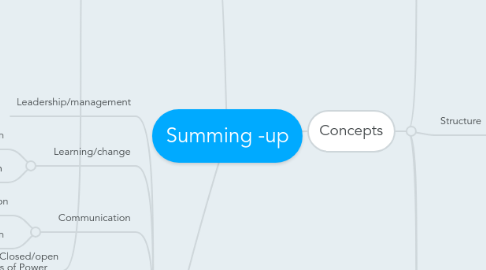
1. Perspectives
1.1. Rational
1.1.1. Taylor
1.1.2. Fayol
1.1.3. Weber
1.2. Natural
1.2.1. Contingency theory
1.2.2. Human relations/humanistic psychology
1.2.3. Barnard/Selznik
1.2.4. Herzberg
1.2.4.1. Motivation/Hygiene
1.2.4.1.1. satisfiers
1.2.4.1.2. dissatisfiers
1.2.5. Maslow
1.2.5.1. Hierarchy of Needs
1.2.5.1.1. Self-actualisation
1.2.5.1.2. esteem
1.2.5.1.3. love / belonging
1.2.5.1.4. safety
1.2.5.1.5. physiological needs
1.3. Closed/open
2. Processes
2.1. Leadership/management
2.2. Learning/change
2.2.1. Adaptation
2.2.2. Innovation
2.3. Communication
2.3.1. Identification
2.3.2. Persuasion
2.4. Power
2.4.1. Sources of Power
2.4.1.1. Structure
2.4.2. Types of Power
2.4.2.1. Force
2.4.2.2. Manipulation
2.4.2.3. Persuasion
2.4.2.4. Authority
2.4.3. Forms of Power
2.4.3.1. Tokens
2.4.3.1.1. Anonymous
2.4.3.1.2. Publicity
2.4.3.2. Position
2.4.3.3. Social and Normative Power
2.4.4. Oppressive
2.4.5. Productive
2.5. Conflict
2.5.1. Emotional
2.5.2. Latent
2.5.3. Disagreement
2.5.4. Manifest
3. Concepts
3.1. 50/50
3.1.1. Structural: Managers can decide
3.1.1.1. specialization
3.1.1.2. standardization
3.1.1.3. standardization of employment practices
3.1.1.4. formalization
3.1.1.5. centralization
3.1.1.6. configuration
3.1.2. Contextual: Managers have to accept
3.1.2.1. origin of the organization
3.1.2.2. ownership
3.1.2.3. charter technologies
3.1.2.4. location
3.1.2.5. interdependence- how are consumer - supplier related etc.
3.2. Structure
3.2.1. Henry Mintzberg
3.2.1.1. Coordinating mechanisms
3.2.1.2. Startegic apex
3.2.1.3. 5 theories of organizational structure
3.2.1.3.1. Matrix structure
3.2.1.3.2. Distribution of labor
3.2.1.3.3. Network structure
3.2.1.3.4. flowing lines of decision
3.2.1.3.5. Market-based structure
3.2.1.4. Types of organizations
3.2.1.4.1. Machine bureacracy
3.2.1.4.2. Professionalized bureacracy
3.2.1.4.3. Divisonalized form
3.2.1.4.4. Adhocracy
3.2.2. Organic vs. mechanic systems
3.2.3. Difference between structure and design
3.2.3.1. Design:
3.2.3.2. Structure:
3.2.4. Pugh
3.2.5. Max Weber
3.2.5.1. Beaucracy
3.2.5.1.1. Authority lies in the person (see types of leaderships)
3.2.5.1.2. Organisations divided into hierarchies
3.3. Environment
3.3.1. Instutionalism
3.3.2. Population ecology
3.4. Culture
3.4.1. Schein
3.4.1.1. Three levels
3.4.1.1.1. Artefacts
3.4.1.1.2. Espoused values
3.4.1.1.3. Basic underlying assumptions
3.4.1.2. Culture is something you have, are or do
3.4.2. Weick
3.4.2.1. Sensemaking
3.4.2.1.1. Organizations ARE culture
3.4.2.1.2. Symbolic view (interoperation)
3.4.2.1.3. Differentation
3.4.2.2. Entactment
3.4.2.2.1. Organizations DO culture
3.4.2.2.2. Symbolic view (construction)
3.4.2.2.3. Fragmentaiton
